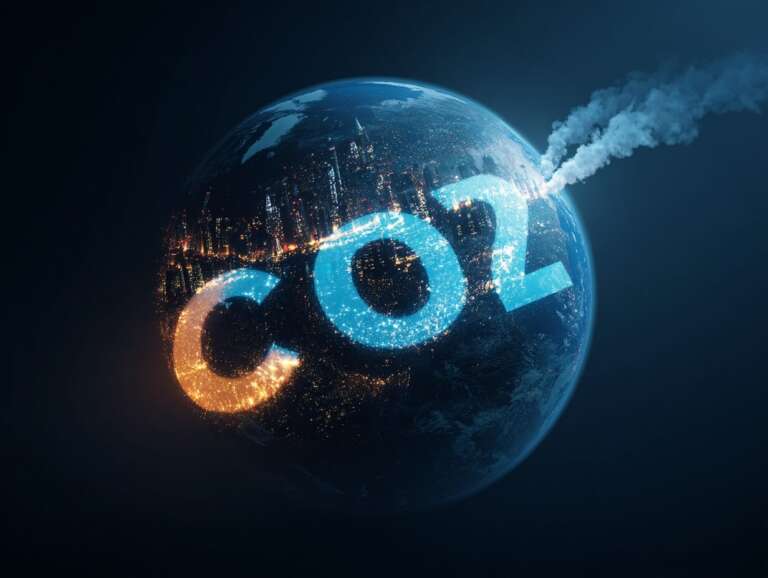As climate change continues to escalate, the world finds itself at a critical juncture. With rising CO2 emissions fueling extreme weather and environmental degradation, the need for cohesive international policies has never been more urgent. The reality is shocking: the planet is on track to exceed a 1.5°C increase in global temperatures, a threshold that could unleash catastrophic consequences. In this article, we’ll explore the global efforts made to tackle CO2 emissions, examining key climate agreements and their effectiveness in driving climate action.
TL;DR: International policies on CO2 emissions are crucial for global climate action. Major climate agreements like the Paris Agreement set ambitious targets for nations. Collaborative efforts among countries showcase the potential for a sustainable future. Understanding these policies empowers citizens and leaders to advocate for stronger climate action.
The Urgency of Addressing CO2 Emissions
Here’s the brutal truth: CO2 levels are skyrocketing. In 2022 alone, global CO2 emissions reached a staggering 36.4 billion metric tons, a figure that continues to rise despite international pledges to reduce them. This increase is not just a number; it translates to more frequent and severe natural disasters, from hurricanes to wildfires, wreaking havoc on communities worldwide. The Intergovernmental Panel on Climate Change (IPCC) warns that if we don’t act swiftly, we could face irreversible damage to our ecosystems and human health.
The link between CO2 levels and climate change effects is undeniable. As global temperatures rise, so do the risks of droughts, floods, and heatwaves. This is not a distant threat; it’s happening now, and the urgency for effective CO2 international policies has never been clearer. The question is: are we ready to confront this challenge head-on?
Key Climate Agreements Shaping CO2 Policies
Let’s dive into the game-changers. The Paris Agreement, adopted in 2015, is a landmark accord that aims to limit global warming to well below 2°C, with aspirations to keep it under 1.5°C. This agreement has galvanized nations to commit to ambitious targets, but it’s more than just a piece of paper; it’s a framework for accountability. Countries like the United States and China, the world’s largest emitters, have made significant pledges, but the real test lies in their implementation.
Before Paris, there was the Kyoto Protocol, which laid the groundwork for international climate action. Though it had its limitations, it marked the first time countries agreed to legally binding emissions targets. Fast forward to today, and initiatives like the Glasgow Climate Pact are pushing the envelope further, urging nations to accelerate their commitments. The stakes are high, and the potential for transformative change is within our grasp. But will we seize the moment?
Enforcement Mechanisms: How Are Policies Implemented?
Here’s what most people miss: having policies is one thing, but enforcing them is another beast entirely. Tracking CO2 emissions and ensuring compliance is a monumental task. The United Nations Framework Convention on Climate Change (UNFCCC) plays a pivotal role in this process, but challenges abound. Countries often face political and economic pressures that hinder their ability to meet targets.
Take the case of Brazil, which has faced criticism for its deforestation rates despite commitments to reduce emissions. On the flip side, countries like Germany have successfully implemented robust tracking systems that hold them accountable. The reality is that global action requires not just agreements but mechanisms that ensure compliance and transparency. Without these, we risk falling into the trap of empty promises.
Success Stories: Countries Leading the Way
Now, let’s shine a light on the heroes of the climate crisis. Countries like Sweden and Costa Rica are leading the charge with innovative CO2 international policies that are not only ambitious but also effective. Sweden aims to be carbon neutral by 2045, and it’s making strides through investments in renewable energy and sustainable practices. Meanwhile, Costa Rica has achieved an impressive 99% renewable energy generation, showcasing that economic growth and environmental sustainability can go hand in hand.
These success stories are more than just feel-good tales; they demonstrate the economic benefits of transitioning to low-carbon economies. As these nations show, investing in green technologies can create jobs, boost local economies, and ultimately lead to a more sustainable future. The question is: can other countries follow suit, or will they remain stuck in the fossil fuel past?
Barriers to Effective Climate Action
But let’s not sugarcoat it—there are significant barriers to effective climate action. Political and economic challenges loom large, often stifling progress. The fossil fuel industry, with its deep pockets and powerful lobbying, poses a formidable obstacle. In many countries, public support for climate initiatives fluctuates, influenced by misinformation and economic fears.
For instance, in the United States, debates over climate policies often become battlegrounds for political ideologies, leading to stagnation in meaningful action. This is where climate agreements can falter; without widespread public support and political will, even the most ambitious plans can crumble. It’s a harsh reality, but one we must confront if we hope to make real progress.
The Future of CO2 International Policies
Looking ahead, the future of CO2 international policies hangs in the balance. Upcoming international meetings, like the COP summits, hold the potential to reshape global climate action. Innovations in policy frameworks, such as carbon pricing and emissions trading systems, are gaining traction and could provide the necessary incentives for countries to reduce their emissions.
But here’s the kicker: public engagement is crucial. Grassroots movements are proving that ordinary citizens can drive change, pushing governments to take bolder actions. The power of collective action cannot be underestimated; when people unite for a common cause, they can challenge the status quo and demand accountability. The future is not set in stone; it’s ours to shape.
Conclusion
The global community is making strides in addressing CO2 emissions through various international policies, but the journey is far from over. Active participation from both governments and citizens is crucial in shaping a sustainable future. The reality is that we all have a role to play in this fight against climate change.
Get involved in local climate initiatives and stay informed about international policies to advocate for meaningful change. The time to act is now—because the future of our planet depends on it.

